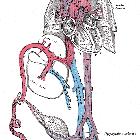fetaler Blutkreislauf




Fetal circulation differs from the adult circulation due to the presence of certain vessels and shunts.
These shunts close after birth, and most of the fetal vessels are visible as remnants in the adult circulation. The function of these shunts is to direct oxygen-rich venous blood to the systemic circulation and to ensure oxygen-deplete venous blood bypasses the underdeveloped pulmonary circulation. There are three shunts in the fetal circulation:
Pathway for oxygenated blood
The lungs finish their development after birth. Before this, the lung's function is taken over by the placenta, which is the oxygen-transfer organ during fetal life.
Oxygen-rich blood is carried by the umbilical vein from the placenta to the fetus. The umbilical vein enters at the umbilicus and reaches the anteroinferior portion of the liver to finally drain in the portal sinus . The ductus venosus connects the portal sinus with the confluence of the hepatic veins into the inferior vena cava.
Appropriate channelling of blood flow is required to ensure sufficient oxygen and nutrient supply to vital organs. This is achieved by unique features of blood vessels which help create differences in velocities and direction of blood flow.
Role of ductus venosus
The ductus venosus diameter is one-third the diameter of the umbilical vein hence the blood is shunted to the IVC under pressure. This increased pressure propels the blood in the IVC to the right atrium and directly into the left atrium via another shunt, the foramen ovale. The blood then passes into the systemic circulation via the left ventricle and aorta.
Pathway for deoxygenated blood
The carbon dioxide-rich blood from the brain and upper extremities returns to the right atrium via the superior vena cava. This blood passes into the right ventricle and is then shunted directly into the descending aorta from the proximal left pulmonary artery via the ductus arteriosus. This occurs because the lungs are not developed and the pulmonary arteries offer high resistance to blood flow.
At the same time blood from the hepatic circulation and lower extremities returns via the inferior vena cava to the heart and it passes into descending aorta through the path of the right ventricle, pulmonary artery and ductus arteriosus.
All of this blood passes into circulation and is carried via umbilical arteries back to the placenta for oxygenation.
Note: a very small amount of blood does get filtered by the lungs and reaches the left atrium via pulmonary veins.
Siehe auch:
und weiter:

 Assoziationen und Differentialdiagnosen zu fetaler Blutkreislauf:
Assoziationen und Differentialdiagnosen zu fetaler Blutkreislauf:
